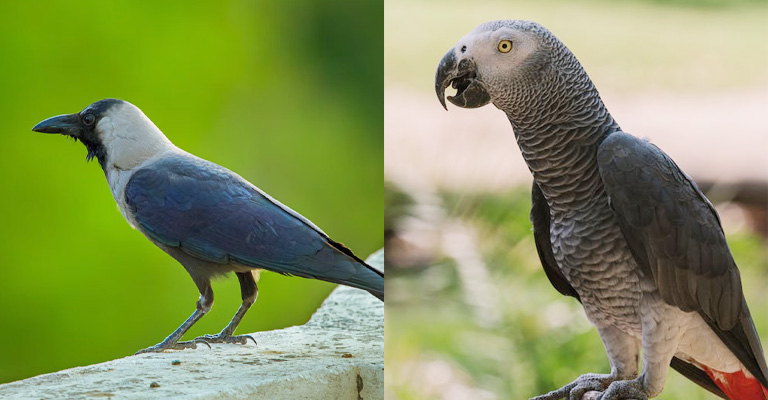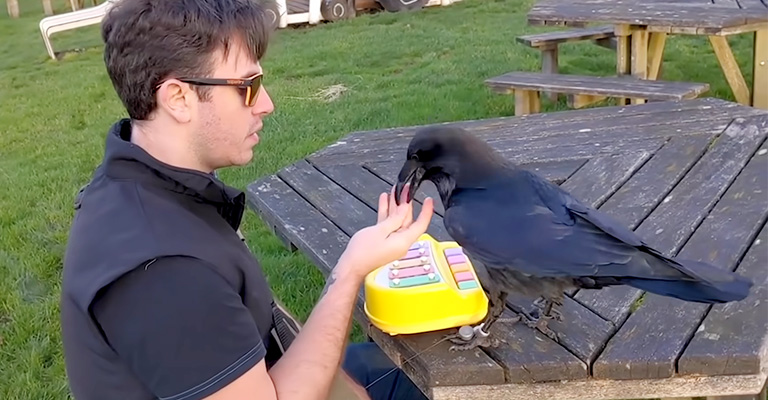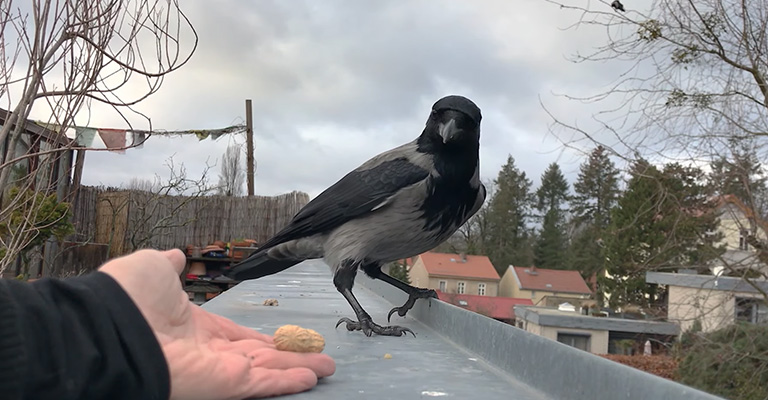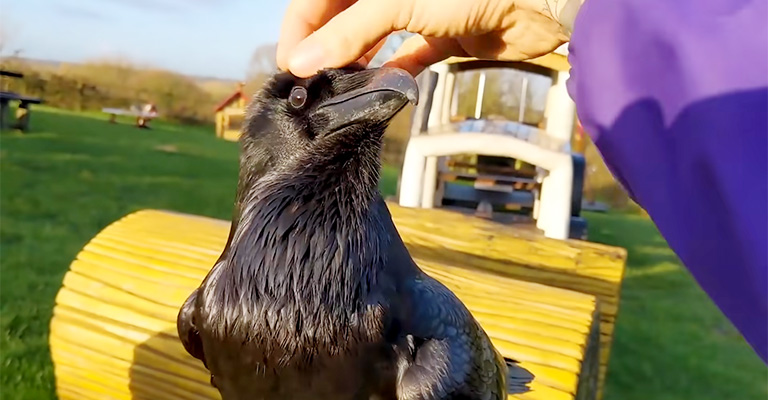When it comes to intelligent and trainable birds, parrots often steal the spotlight. Their ability to mimic human speech and perform various tricks has made them popular pets and performers.
However, there is another avian species that possesses remarkable intelligence and problem-solving skills: crows. Crows are known for their adaptability, complex social structures, and ability to use tools.
But can crows be trained like parrots? In this article, we will explore the potential for training crows, their cognitive abilities, and the challenges and benefits of working with these fascinating birds.

Can Crows Be Trained Like Parrots?
Crows are highly intelligent birds and can indeed be trained, but their training capabilities are different from those of parrots. Crows belong to the Corvidae family, which includes ravens, magpies, and jays. These birds have long been recognized for their exceptional intelligence.
Research has shown that crows possess advanced cognitive abilities, including problem-solving skills, tool use, and even the ability to recognize themselves in mirrors. Their brain-to-body size ratio is comparable to that of great apes, indicating a high level of intelligence.
Crows are wild birds with different sets of instincts and behaviors. They are less inclined to form strong bonds with humans and may be more wary and independent.
However, this does not mean that crows cannot be trained. It simply means that training crows may require a different approach and understanding of their natural behaviors.
How Do You Teach A Crow To Talk?

Teaching a crow to talk or mimic human speech is a challenging task, as it goes against their natural vocal abilities and instincts. While crows are intelligent and capable of learning, their vocalizations are distinct from human speech.
However, if you are interested in attempting to teach a crow to imitate certain sounds or words, here are some general steps you could follow:
Bond and Build Trust
Develop a bond with the crow and gain its trust. This can be done by providing regular food and positive interactions without causing stress or harm to the bird. It may take time for the crow to feel comfortable around you.
Choose Simple Sounds
Start by selecting simple sounds or words that are easier for the crow to imitate. These could include short, distinct sounds or repetitive words. For example, you could choose a single syllable like “hello” or a repeated sound like a whistle.
Repetition and Reinforcement
Consistently repeat the chosen sound or word in the presence of the crow. Use positive reinforcement techniques, such as providing treats or rewards, when the crow makes attempts to imitate the sound. This positive association can encourage the crow to continue trying to mimic the sound.
Audio Recordings
Play recordings of the desired sounds or words for the crow. Hearing the sounds repeatedly may help the crow in understanding and attempt to reproduce them.
Patience and Consistency
Teaching a crow to talk requires patience, consistency, and repetition. Work with the crow regularly in short training sessions, and be prepared for slow progress. Not all crows will have the same level of aptitude or interest in imitating human speech.
Remember that the ability of a crow to imitate human speech is not a natural behavior for the species, so success may be limited. It’s essential to approach this with realistic expectations and prioritize the well-being of the crow throughout the training process.
Training Techniques for Crows

To train a crow, you can utilize the following techniques:
Positive Reinforcement
Like parrots, crows respond well to positive reinforcement training. This involves rewarding desired behaviors with treats or praise. By associating a specific behavior with a reward, crows can learn to repeat that behavior.
Clicker Training
Clicker training is a popular method used to train a variety of animals, including parrots. It involves using a clicker to mark the desired behavior, followed by a reward. Crows can be trained to associate the sound of the clicker with a reward, making it an effective training tool.
Target Training
Target training involves teaching a bird to touch a specific object, such as a stick or a target stick, with its beak or feet. This technique can be used to teach crows to perform specific actions or tricks.
Problem-Solving Tasks
Crows excel at problem-solving tasks. By presenting them with puzzles or challenges, such as retrieving food from a locked container, crows can be trained to use their intelligence and problem-solving skills to find a solution.
Can All Crows Be Taught to Speak?

No, not all crows can be taught to speak like parrots. While individual crows may have the ability to mimic certain sounds, including human speech, it is not a common behavior exhibited by the species as a whole.
Mimicking human speech is more commonly associated with parrots, particularly certain species like African grey parrots and Amazon parrots. Crows have their own unique vocalizations and communication system, which involves a variety of calls, caws, and other sounds.
They are highly intelligent birds and can learn to associate specific sounds with certain situations or events. However, their natural vocalizations and communication are different from their ability to speak human words and phrases.
While it is theoretically possible to teach a crow to imitate some words or sounds through intensive training and positive reinforcement, it would likely require exceptional circumstances and considerable effort. It is not a behavior that can be expected or commonly observed in crows.
It’s important to appreciate and understand crows for their own vocal and communicative abilities rather than expecting them to mimic human speech as parrots do.
How Do Crows Talk?
Crows communicate with each other through a variety of vocalizations. Their vocal repertoire includes a range of calls, caws, and other sounds that serve different purposes in their communication system. Here are some common ways in which crows talk:
Cawing
The most well-known vocalization of crows is their caw. Caws can vary in pitch, duration, and intensity, and different caw patterns may convey different meanings. Crows often caw to communicate their presence, warn of potential threats, or establish territory.
Alarm Calls
Crows have specific alarm calls that they use to alert others in their group about potential dangers or predators. These alarm calls are usually loud, harsh, and repeated several times to grab the attention of nearby crows and prompt a coordinated response.
Vocalizing in Groups
When crows gather in groups, they engage in vocal interactions that involve a combination of caws, rattles, and other unique vocalizations. These group vocalizations help them coordinate activities, maintain social bonds, and communicate important information within their flock.
Vocal Mimicry
While not as proficient as parrots, some crows can mimic certain sounds in their environment, including human speech, other bird calls, or even mechanical sounds. This mimicry is not as extensive or complex as parrots, but it demonstrates their capacity to learn and imitate certain sounds.
Non-vocal Communication
Crows also communicate through non-vocal means, such as body language, postures, and gestures. They use these visual cues, along with their vocalizations, to convey information and intentions to other crows.
It’s worth noting that crows have a highly complex and sophisticated communication system that scientists are still studying. They are capable of conveying a wide range of messages through variations in their vocalizations.
What’s the Most Common Word That Crows Will Say?
Crows are not known for mimicking or imitating human speech as extensively as some other birds, such as parrots.
While individual crows may occasionally mimic certain sounds, including human speech, it is not common for them to consistently repeat specific words or phrases as parrots do.
Instead, crows have a wide repertoire of natural vocalizations that they use to communicate with each other. Their most characteristic vocalization is the caw, which is a harsh, cawing sound.
The caw is a versatile call that crows use for various purposes, including communicating their presence, warning of danger, or establishing territory.
It’s important to understand that crows’ communication primarily consists of their own natural vocalizations rather than imitating or saying specific words. Their vocalizations have specific meanings within their own social and communicative context.
FAQs
Yes, crows are known for their problem-solving abilities. They can demonstrate innovative thinking to overcome obstacles and obtain food. For example, they have been observed using tools to extract food from hard-to-reach places or using cars to crack open nuts by placing them on roads and waiting for vehicles to crush the shells.
Yes, crows have been shown to have the ability to recognize and remember individual human faces. They can associate specific individuals with positive or negative experiences and adjust their behavior accordingly.
Crows are highly social birds and often live in family groups. They engage in cooperative behaviors and have a complex social structure within their communities. They communicate with each other using a variety of vocalizations and body language, allowing them to coordinate activities and warn others of potential threats.
While crows are not as well-known for their mimicry abilities as parrots, they are still capable of imitating some sounds, including the vocalizations of other animals. They can mimic the calls of other bird species or even imitate human speech to a limited extent.
Crows are you it yet not typically kept as pets like parrots. While it is possible to form a bond with a crow and train it to some extent, they are wild birds and have specialized needs that may not be met in a domestic environment.
Bottom line
So, can crows be trained like parrots? While parrots have long been regarded as the epitome of trainable birds, crows possess their own unique set of skills and intelligence.
With the right approach and understanding of their natural behaviors, crows can be trained to perform tricks, solve problems, and demonstrate their remarkable cognitive abilities.
Training crows not only provides mental stimulation for these birds but also offers insights into their complex social structures and behaviors. So, while parrots may steal the spotlight, let us not overlook the incredible potential of training crows.